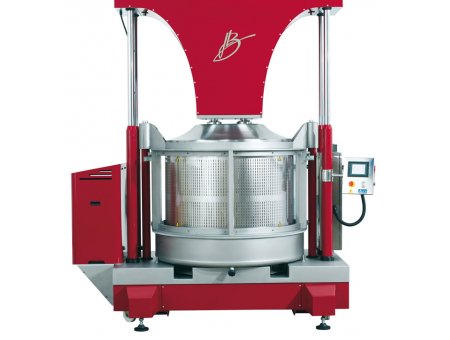Vertical press
Vertical presses, also known as cage or basket presses, are traditional winemaking equipment that have been in use for centuries.
Although their design is ancient, they remain popular in many vineyards for their ability to produce high-quality musts with gentle extraction.
These presses are particularly popular for wines for ageing and small-scale production, where respect for tradition and mastery of the process are essential.
Although their design is ancient, they remain popular in many vineyards for their ability to produce high-quality musts with gentle extraction.
These presses are particularly popular for wines for ageing and small-scale production, where respect for tradition and mastery of the process are essential.

Introduction to vertical presses
Pressing is more respectful and gentler than with the old models of continuous screw or horizontal plate presses. Pressed wines are of better quality, provided there is no crushing upstream. The cages or baskets were originally made of wood, but are now available in stainless steel or other materials that make them easier to clean and maintain over the long term.
Their small capacity, generally 3 or 5 HL, can be increased to 20 HL depending on the model, making it possible to adapt to and respect the plot of each vat for small to medium-sized batches.

Vertical press basket
Mode of operation
The operation of vertical presses is relatively simple and relies on a system of pressure applied from top to bottom. Here are the main stages in their operation:- Loading the grapes: The grapes, destemmed or whole, are placed in a wooden or steel cage or basket, perforated to allow the juice to drain out.
- Applying pressure: A pressing plate is lowered onto the grapes, generally using a mechanical system (auger) or hydraulic cylinder. The pressure is applied vertically, pressing the grapes against the bottom of the cage.
- Juice extraction: The juice flows through the perforations in the cage and is collected in a vat, often using a pump. This process is often accompanied by several pressing cycles to maximise extraction.
- Removal of pomace: Once pressing is complete, the pomace (the solid residue) is removed manually for possible treatment or recycling.
Settings
Vertical presses, although mechanically simple, allow certain adjustments to be made to suit the pressing process:- Pressure level: Pressure can be adjusted manually or via a hydraulic system, giving precise control over the force applied.
- Duration of pressing cycles: Cycles can be adjusted according to grape type and desired must concentration.
- Pressing speed: In some models, it is possible to control the speed at which pressure is applied to avoid extraction that is too fast or too violent.
Advantages and disadvantages
Advantages
- Must quality: Vertical presses ensure gentle extraction, preserving the delicate aromas and flavours of the grapes.
- Simplicity and reliability: Their simple design makes them easy to use and maintain, with little risk of breakdown.
- Tradition and authenticity : Ideal for producers looking to retain traditional winemaking methods.
- Flexibility: Capable of handling small quantities of grapes, they are ideal for micro-vinifications or special cuvées.
Disadvantages
- Limited capacity: Often less suitable for large-scale production due to their limited capacity.
- Processing time: The pressing process can be slower compared to other types of modern press.
- Physical effort: Manual models require more effort to apply pressure and remove the marc.
